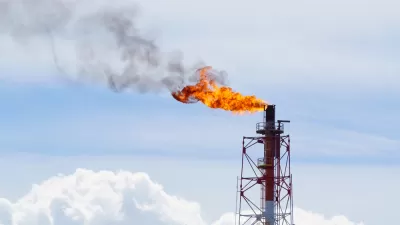Andrew C. Revkin follows researchers in Boston on the hunt to map and measure leaky pipes hemorrhaging natural gas out onto the street.
Households throughout America have long relied on natural gas to keep warm through the winters, but in many cities, the network of pipes they depend on are long overdue for a facelift. Researchers from Boston and Duke Universities set out earlier this year to track down and measure how much gas is slipping through the cracks in Boston.
After a 785-mile tour of the city in a gas-analyzer-equipped van, they found some 3,300 leaks throughout the city. "We know from just dozens of chamber measurements that some of the leaks can exceed daily U.S. household usage (200 cubic feet a day)," said lead researcher Nathan Phillips. "I think the distribution is skewed with a long tail — many small leaks, and a few really big ones."
Notes Revkin, "It takes money to fix such problems. Tokyo has become a global leader in stanching water leaks, for example. A core component of that fix has been costly stainless steel pipes. Updating invisible infrastructure also takes a culture shift."
Most often, the leaks occur not along pipes themselves, but at joints where the sealant has deteriorated. Cast iron pipes, while only accounting for 3 percent of infrastructure mileage, represent the largest source of fugitive emissions. "We should be replacing underground infrastructure when we are already repaving streets," wrote Phillips in an email, "rather than addressing one infrastructure in isolation of the others. It would save a lot of money."
Phillips hopes his team's research will shed light on the environmental magnitude of the problem: "Every molecule of natural gas that floats into the air has somewhere between 20 and 30 times the greenhouse gas potential of a CO2 molecule that would have resulted if that same natural gas molecule was burned to heat someone's home."
FULL STORY: Mapping Gas Leaks from Aging Urban Pipes

Alabama: Trump Terminates Settlements for Black Communities Harmed By Raw Sewage
Trump deemed the landmark civil rights agreement “illegal DEI and environmental justice policy.”

Planetizen Federal Action Tracker
A weekly monitor of how Trump’s orders and actions are impacting planners and planning in America.

Why Should We Subsidize Public Transportation?
Many public transit agencies face financial stress due to rising costs, declining fare revenue, and declining subsidies. Transit advocates must provide a strong business case for increasing public transit funding.

Understanding Road Diets
An explainer from Momentum highlights the advantages of reducing vehicle lanes in favor of more bike, transit, and pedestrian infrastructure.

New California Law Regulates Warehouse Pollution
A new law tightens building and emissions regulations for large distribution warehouses to mitigate air pollution and traffic in surrounding communities.

Phoenix Announces Opening Date for Light Rail Extension
The South Central extension will connect South Phoenix to downtown and other major hubs starting on June 7.
Urban Design for Planners 1: Software Tools
This six-course series explores essential urban design concepts using open source software and equips planners with the tools they need to participate fully in the urban design process.
Planning for Universal Design
Learn the tools for implementing Universal Design in planning regulations.
Caltrans
Smith Gee Studio
Institute for Housing and Urban Development Studies (IHS)
City of Grandview
Harvard GSD Executive Education
Toledo-Lucas County Plan Commissions
Salt Lake City
NYU Wagner Graduate School of Public Service




























